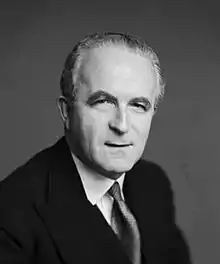Cyril Radcliffe, 1st Viscount Radcliffe
Cyril John Radcliffe, 1st Viscount Radcliffe, GBE, PC, QC, FBA (30 March 1899 – 1 April 1977) was a British lawyer and Law Lord best known for his role in the partition of British India. He served as the first chancellor of the University of Warwick from its foundation in 1965 to 1977.
The Viscount Radcliffe | |
|---|---|
 | |
| Lord of Appeal in Ordinary | |
| In office 1949–1964 | |
| Personal details | |
| Born | Cyril John Radcliffe 30 March 1899 Llanychan, Denbighshire, Wales |
| Died | 1 April 1977 (aged 78) |
| Nationality | British |
| Spouse(s) | Antonia Mary Roby Benson
(m. 1939) |
| Alma mater | University of Oxford |
Background, education and early career
Radcliffe was born in Llanychan, Denbighshire, Wales, the son of an army captain. His maternal grandfather was President of the Law Society between 1890 and 1891.
Radcliffe was educated at Haileybury College. He was then conscripted in World War I but his poor eyesight limited the options for service so he was allocated to the Labour Corps. After the War, he attended New College, Oxford as a scholar, and took a first in literae humaniores in 1921. In 1922 he was elected to a prize fellowship at All Souls College, Oxford. He won the Eldon Law Scholarship in 1923.
He was called to the bar by the Inner Temple in 1924, and joined the chambers of Wilfred Greene, later the Master of the Rolls. He practised at the Chancery bar, and was appointed a King's Counsel in 1935.
During World War II, Radcliffe joined the Ministry of Information becoming its Director-General by 1941, where he worked closely with the Minister Brendan Bracken. In 1944 he was made a Knight Commander of the Order of the British Empire (KBE). He returned to the bar in 1945.
Indian Boundary Committees
Radcliffe, a man who had never been east of Paris,[1] was given the chairmanship of the two boundary committees set up with the passing of the Indian Independence Act. He was faced with the daunting task of drawing the borders for the new nations of Pakistan and India in a way that would leave as many Hindus and Sikhs in India and Muslims in Pakistan as possible. Radcliffe submitted his partition map on 9 August 1947, which split Punjab and Bengal almost in half. The new boundaries were formally announced on 17 August 1947 – three days after Pakistan's independence and two days after India became independent of the United Kingdom.[2]
Radcliffe's efforts saw some 14 million people – roughly seven million from each side – flee across the border when they discovered the new boundaries left them in the "wrong" country. In the violence that ensued after independence, estimates of loss of life accompanying or preceding the partition vary between several hundred thousand and two million,[3][lower-alpha 1] and millions more were injured. After seeing the mayhem occurring on both sides of the boundary, Radcliffe refused his salary of 40,000 rupees (then 3,000 pounds). He was made a Knight Grand Cross of the Order of the British Empire in 1948.
The poet W. H. Auden referred to Radcliffe's role in the partition of India and Pakistan in his 1966 poem "Partition".[4]
Later career
In 1949, Radcliffe was made a Lord of Appeal in Ordinary, sworn of the Privy Council, and created a life peer as Baron Radcliffe, of Werneth in the County of Lancaster.[5] Unusually, he had not previously been a judge. In the 1940s and 1950s he chaired a string of public enquiries in addition to his legal duties and continued to hold numerous trusteeships, governorships and chairmanships right up until his death. He chaired the Committee of Enquiry into the Future of the British Film Institute (1948), whose recommendations led to the modernisation of the BFI in the post-war period.
From 1957 he was chairman of the Radcliffe Committee, called to enquire into the working of the monetary and credit system. The committee published a report known as the Radcliffe report which suggested reforms on how monetary policy is run. He was also a frequent public speaker and wrote numerous books: he gave the BBC Reith Lecture in 1951 – a series of seven broadcasts titled Power and the State which examined the features of democratic society, and considered the problematic notions of power and authority. He also presented the Oxford University Romanes Lecture in 1963 on Mountstuart Elphinstone.[6]
In 1962 he was made a hereditary peer as Viscount Radcliffe, of Hampton Lucy in the County of Warwick.[7]
Personal life
Lord Radcliffe married Antonia Mary Roby, daughter of Godfrey Benson, 1st Baron Charnwood and former wife of John Tennant, in 1939. He died in April 1977, aged 78. He had no issue and the viscountcy of Radcliffe became extinct on his death.
In 2006, two sets of Chancery barristers' chambers in Lincoln's Inn merged and adopted the name "Radcliffe Chambers" in his honour.[8]
Arms
  |
|
See also
Notes
- "The death toll remains disputed with figures ranging from 200,000 to 2 million."[3]
References
- Partition: The Day India Burned (Television production). BBC. 14 August 2007.
- Pillallamari, Akhilesh (19 August 2017). "70 Years of the Radcliffe Line: Understanding the Story of Indian Partition". The Diplomat. The Diplomat. Retrieved 21 January 2021.
- Talbot & Singh 2009, p. 2.
- Auden, W. H. (1976). Collected Poems. p. 604.
- "No. 38627". The London Gazette. 3 June 1949. p. 2748.
- "Romanes Lectures since 1892". University of Oxford. Retrieved 11 January 2014.
- "No. 42729". The London Gazette. 13 July 1962. p. 5563.
- "History of Chambers l Radcliffe Chambers". Archived from the original on 6 March 2016. Retrieved 5 March 2016.
- "Radcliffe, Viscount (UK, 1962 – 1977)". www.cracroftspeerage.co.uk.
Further reading
- Chester, Lucy P. Borders and Conflict in South Asia: The Radcliffe Boundary Commission and the Partition of Punjab. Manchester UP, 2009.
| Academic offices | ||
|---|---|---|
| Preceded by New university |
Chancellor of the University of Warwick 1965–1977 |
Succeeded by The Lord Scarman |
| Peerage of the United Kingdom | ||
| New creation | Viscount Radcliffe 1962–1977 |
Extinct |